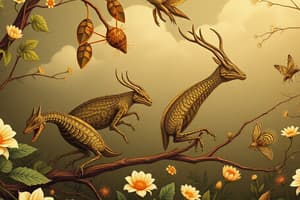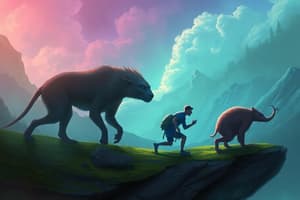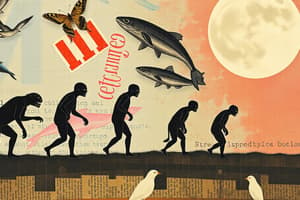Podcast
Questions and Answers
What is the founder effect?
What is the founder effect?
A small group separating from a larger group
What are the two main points of Darwin's theory of evolution?
What are the two main points of Darwin's theory of evolution?
- Species change over time because of the use or disuse of organs
- Species evolve by acquiring characteristics from their environment
- Species living today descended from ancestral species in what Darwin called "descent with modification." (correct)
- Natural Selection is a mechanism for evolution (correct)
What did Wallace propose about evolution?
What did Wallace propose about evolution?
Over generations, natural selection of inherited traits could give rise to new species.
What is the fossil record?
What is the fossil record?
What is biogeography?
What is biogeography?
What is convergent evolution?
What is convergent evolution?
What are direct observations?
What are direct observations?
What is natural selection?
What is natural selection?
What is artificial selection?
What is artificial selection?
What are homologies?
What are homologies?
What is the mechanism of natural selection?
What is the mechanism of natural selection?
What is descent with modification?
What is descent with modification?
What is homology?
What is homology?
What is a homologous structure?
What is a homologous structure?
What is a fossil?
What is a fossil?
What is a vestigial structure?
What is a vestigial structure?
What is an evolutionary tree?
What is an evolutionary tree?
What is an adaptation?
What is an adaptation?
What is evolution?
What is evolution?
Why is the smallest unit of evolution a population?
Why is the smallest unit of evolution a population?
How does genetic variation arise in populations?
How does genetic variation arise in populations?
Why is genetic variation necessary for natural selection?
Why is genetic variation necessary for natural selection?
What is the Hardy-Weinberg equilibrium?
What is the Hardy-Weinberg equilibrium?
What are the 5 conditions needed for Hardy-Weinberg equilibrium?
What are the 5 conditions needed for Hardy-Weinberg equilibrium?
What is directional selection?
What is directional selection?
What is disruptive selection?
What is disruptive selection?
What is stabilizing selection?
What is stabilizing selection?
What is balancing selection?
What is balancing selection?
Natural selection is goal oriented and can produce perfect organisms.
Natural selection is goal oriented and can produce perfect organisms.
Why does genetic drift have a greater effect on smaller populations?
Why does genetic drift have a greater effect on smaller populations?
What is a gene pool?
What is a gene pool?
What is a population?
What is a population?
What is the bottleneck effect?
What is the bottleneck effect?
What is genetic drift?
What is genetic drift?
What is fitness?
What is fitness?
What is horizontal gene transfer?
What is horizontal gene transfer?
What is a biological species?
What is a biological species?
How does a single species become two species?
How does a single species become two species?
Why is reproductive isolation necessary for divergence in populations?
Why is reproductive isolation necessary for divergence in populations?
What are the eight mechanisms of reproductive isolation?
What are the eight mechanisms of reproductive isolation?
How does sympatric speciation occur?
How does sympatric speciation occur?
What is allopatric speciation?
What is allopatric speciation?
What is speciation?
What is speciation?
What is reproductive isolation?
What is reproductive isolation?
What is the biological species concept?
What is the biological species concept?
What is a hybrid zone?
What is a hybrid zone?
What is Polyploidy?
What is Polyploidy?
What is Intraspecific?
What is Intraspecific?
What is adaptive radiation?
What is adaptive radiation?
How did eukaryotic cells evolve from prokaryotic cells?
How did eukaryotic cells evolve from prokaryotic cells?
What are some of the biases in the fossil record?
What are some of the biases in the fossil record?
What are the main steps for the evolution of life on earth?
What are the main steps for the evolution of life on earth?
What is the age of the Earth?
What is the age of the Earth?
When did prokaryotes appear?
When did prokaryotes appear?
When did multicellular eukaryotes appear?
When did multicellular eukaryotes appear?
When did animals appear?
When did animals appear?
When did land plants appear?
When did land plants appear?
How has Earth's environment changed over history and affected living organisms?
How has Earth's environment changed over history and affected living organisms?
What is radiometric dating?
What is radiometric dating?
How does the depth of a fossil help us understand its relative age?
How does the depth of a fossil help us understand its relative age?
Where did the first living cells evolve?
Where did the first living cells evolve?
How does the spatial expression of genes affect pattern formation?
How does the spatial expression of genes affect pattern formation?
How does early development of an organism help us understand evolutionary relationships?
How does early development of an organism help us understand evolutionary relationships?
What are protocells?
What are protocells?
What are hydrothermal vents?
What are hydrothermal vents?
What are alkaline vents?
What are alkaline vents?
What are ribozymes?
What are ribozymes?
What is an endosymbiont?
What is an endosymbiont?
What is the Cambrian explosion?
What is the Cambrian explosion?
What does unicellular mean?
What does unicellular mean?
What is a prokaryote?
What is a prokaryote?
What is a half-life?
What is a half-life?
What is a monophyletic group?
What is a monophyletic group?
How can neutral mutations spread through populations?
How can neutral mutations spread through populations?
What is the principle of parsimony?
What is the principle of parsimony?
What is a molecular clock?
What is a molecular clock?
How can horizontal gene transfer and convergent evolution complicate drawing phylogenetic trees?
How can horizontal gene transfer and convergent evolution complicate drawing phylogenetic trees?
What is binomial nomenclature?
What is binomial nomenclature?
What is the Hierarchy of taxonomic grouping?
What is the Hierarchy of taxonomic grouping?
What is a taxon?
What is a taxon?
What are sister taxa?
What are sister taxa?
What is an analogy?
What is an analogy?
What is paraphyletic?
What is paraphyletic?
Flashcards
Founder effect
Founder effect
Small group separating from a larger group.
Darwin theory of evolution
Darwin theory of evolution
Species descended from ancestral species via "descent with modification"; Natural selection is a mechanism.
Fossil Record
Fossil Record
Chronological collection of life's remains in sedimentary rock layers.
Natural selection
Natural selection
Signup and view all the flashcards
Artificial selection
Artificial selection
Signup and view all the flashcards
Homologies
Homologies
Signup and view all the flashcards
Adaptation
Adaptation
Signup and view all the flashcards
Bottleneck effect
Bottleneck effect
Signup and view all the flashcards
Gene pool
Gene pool
Signup and view all the flashcards
Evolutionary tree
Evolutionary tree
Signup and view all the flashcards
Gene flow
Gene flow
Signup and view all the flashcards
Directional selection
Directional selection
Signup and view all the flashcards
Disruptive selection
Disruptive selection
Signup and view all the flashcards
Stabilizing selection
Stabilizing selection
Signup and view all the flashcards
Reproductive isolation
Reproductive isolation
Signup and view all the flashcards
Speciation
Speciation
Signup and view all the flashcards
Polyploidy
Polyploidy
Signup and view all the flashcards
Cambrian explosion
Cambrian explosion
Signup and view all the flashcards
Horizontal gene transfer
Horizontal gene transfer
Signup and view all the flashcards
Monophyletic group
Monophyletic group
Signup and view all the flashcards
Morphological species
Morphological species
Signup and view all the flashcards
Taxon
Taxon
Signup and view all the flashcards
Sister taxa
Sister taxa
Signup and view all the flashcards
Biological species concept
Biological species concept
Signup and view all the flashcards
Gene drift
Gene drift
Signup and view all the flashcards
Evolutionary relationships
Evolutionary relationships
Signup and view all the flashcards
Intraspecific competition
Intraspecific competition
Signup and view all the flashcards
Interfpecific competition
Interfpecific competition
Signup and view all the flashcards
Fitness
Fitness
Signup and view all the flashcards
Study Notes
Founder Effect
- A small group separates from a larger group.
Darwin's Theory of Evolution
- Species today descend from ancestral species.
- Natural selection is a mechanism for evolution.
Wallace's Theory of Evolution
- Natural selection of inherited traits can lead to new species over generations.
Fossil Record
- Chronological collection of life's remains in sedimentary rock layers.
Biogeography
- Study of the past and present distribution of organisms.
Convergent Evolution
- Unrelated organisms independently evolve similar traits when adapting to similar environments.
Direct Observations
- Observing phenomena using the five senses.
Natural Selection
- Individuals with advantageous inherited traits tend to survive and reproduce more.
Artificial Selection
- Breeding organisms with desired traits to produce offspring with identical traits.
Homologies
- Similarities between organisms due to shared ancestry.
Mechanism of Natural Selection
- Mutations create genetic diversity.
- Organisms with higher fitness have a greater chance of survival and reproduction.
- Leads to adaptation over time.
Descent with Modification
- Species change over time, inheriting traits from earlier species.
Homology (2)
- Similarity from common ancestry.
Homologous Structure
- Similar structures in different organisms with different functions, demonstrating shared ancestry.
Analogous Structure
- Structures with similar functions but different structures, demonstrating independent adaptation.
Fossil
- Preserved trace of an ancient organism.
Vestigial Structure
- Remnants of structures with a function in ancestors, but have lost their function.
Evolutionary Tree
- Diagram representing hypotheses about evolutionary relationships between organisms.
Adaptation
- Trait that enhances survival and reproduction in a specific environment.
Evolution (2)
- Gradual change in a species over time.
Population as the Unit of Evolution
- Evolutionary changes in allele frequencies within interbreeding populations over time.
Genetic Variation in Populations
- Arises from shifts in allele frequencies.
Genetic Variation and Natural Selection
- Necessary for natural selection to act upon.
Hardy-Weinberg Equilibrium
- p² + 2pq + q² = 1
- p + q = 1
Hardy-Weinberg Equilibrium Conditions
- No selection, mutations, migration, genetic drift, or nonrandom mating.
Directional Selection
- Favors one extreme variation of a trait.
Disruptive Selection
- Favors individuals at both extremes of a trait's range.
Stabilizing Selection
- Favors intermediate variants, acting against extreme traits.
Balancing Selection
- Maintains two or more phenotypic forms in a population.
Natural Selection's Limitations
- Not goal-oriented.
- Cannot produce perfect organisms.
Genetic Drift in Small Populations
- More pronounced effect in smaller populations due to speed of change.
Gene Pool
- Combined genetic information of all members of a population.
Population
- Group of individuals of the same species in the same area.
Microevolution
- Evolutionary change within a species or small group over a short time.
Macroevolution
- Large-scale evolutionary changes over long periods, resulting in new species or major evolutionary trends.
Bottleneck Effect
- Genetic diversity reduced by a drastic decrease in population size, usually due to a random event.
Genetic Drift (2)
- Random changes in allele frequencies in small populations.
Gene Flow
- Movement of alleles between populations.
Migration
- Form of relocation diffusion involving permanent move to a new location.
Fitness
- Ability of an organism to survive and reproduce.
Mutation
- Change in DNA sequence.
Horizontal Gene Transfer
- Transfer of genes between genomes (not parent to offspring)
Biological Species Concept
- Species is a group of populations with the potential for interbreeding.
Hybrid Zone
- Region where different species meet and interbreed, occasionally producing offspring.
Polyploidy
- Having extra sets of chromosomes.
Hybrid
- Offspring from crosses between parents of different traits.
Intraspecific Variation
- Variations within a single species.
Interspecific Competition
- Competition between different species.
Adaptive Radiation
- Single species evolves into many descendants with diverse traits.
Eukaryotic Evolution from Prokaryotes
- Endosymbiosis: One prokaryotic cell engulfed another, leading to organelles (mitochondria, chloroplasts).
Biases in the Fossil Record
- Incomplete record.
Main Steps for Evolution of Life:
- Formation of nucleotides and amino acids.
- Polymerization of molecules.
- Enclosing polymers in membranes.
- Origin of self-replicating molecules.
Age of Earth
- 4.6 billion years.
Prokaryotic Appearance
- 3.5 billion years ago
Eukaryotic Appearance
- 1.8 billion years ago
Multicellular Eukaryotes Appearance
- 1 billion years ago
Animal Appearance
- 600 million years ago
Human Appearance
- 2.5 million years ago
Land Plants Appearance
- 500 million years ago
Environmental Changes and Organisms
- Environmental changes (climate, atmosphere, landmasses, etc) affect genetic changes in living organisms
Radiometric Dating
- Measures absolute age using radioactive isotopes and decay products.
Fossil Age and Depth
- Deeper strata = Older fossils
First Living Cell Location
- Oceans
Spatial Gene Expression
- Affects phenotypes
Early Development and Evolutionary Relationships
- Reveals shared ancestry evidenced by similar embryonic features.
Protocells
- Vesicle-like structures containing nucleic acids.
Hydrothermal Vents
- Seafloor openings emitting heated mineral-rich water.
Alkaline Vents
- Deep-sea vents with high pH and warm water.
Ribozymes
- Catalytic RNA molecules acting as enzymes.
Endosymbiont (2)
- Cell living within another cell.
Cambrian Explosion
- Rapid diversification of animal species at the start of the Paleozoic era.
Unicellular
- One-celled organism.
Multicellular
- Many-celled organism.
Prokaryote (2)
- Cell without a nucleus.
Eukaryote (2)
- Cell with a nucleus and membrane-bound organelles.
Half-Life
- Time for half of a radioisotope to decay into its products.
Monophyletic Group
- Group containing a common ancestor and all its descendants
Neutral Mutations and Population Spread
- Genetic drift helps them spread even if not affecting organism fitness
Principle of Parsimony
- Simplest explanation favored, requiring fewest assumptions.
Molecular Clock
- Uses DNA comparisons to estimate time since divergence.
Horizontal Gene Transfer/Convergent Evolution Complication in Phylogenetic Trees
- Gene transfer and convergent evolution muddy true evolutionary paths.
Binomial Nomenclature
- Two-part naming system for species.
Taxonomic Hierarchy
- Kingdom, Phylum, Class, Order, Family, Genus, Species
Taxon (2)
- Group of organisms in a classification system.
Sister Taxa
- Groups sharing an immediate common ancestor.
Analogy (2)
- Similarity due to convergent evolution, not shared ancestry.
Homology (3)
- Similarity due to common ancestry.
Clade (2)
- Group including an ancestor and all its descendants.
Paraphyletic Group
- Group containing a common ancestor and some, but not all, descendants.
Polyphyletic Group
- Group with members from multiple lineages without a common ancestor.
Studying That Suits You
Use AI to generate personalized quizzes and flashcards to suit your learning preferences.




